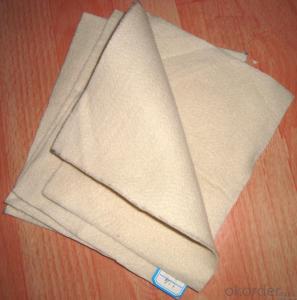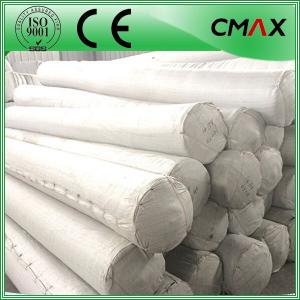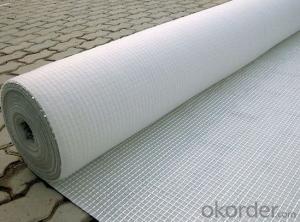Nilex 4551 Non-Woven Geotextile - Non-Woven PET/PP Short Fiber Needle Punched Geotextile for Drainage
- Loading Port:
- China main port
- Payment Terms:
- TT OR LC
- Min Order Qty:
- 1000 m²
- Supply Capability:
- 500000 m²/month
OKorder Service Pledge
OKorder Financial Service
You Might Also Like
Specification
Functions of Short Fiber Needle Punched Non-woven Geotextile:
1. Filtration:
Used as the reversed filter to both prevent sand particulate from passing through and to allow free-flow for water and air.
2.Isolation:
Serving as isolation between ballast and subgrade or subgrade and soft ground in railway, surface course and subgrade or between different dam material in the airport and parking area, to isolate sand, stone in various diameter size from subgrade or other buildings.
3.Reinforcing: Used in engineering of road, railway, earth-rock dam, breakwater, airport, revetment refilling soil, slope and etc, to distribute soil body stress, prevent lateral soil movement and increase stability of soil.
4.Protection:
Used to prevent from scour by wind, wave, tide and/or rain and to protect bank and bottom, to avoid loss of soil and water
Surface Effects of Short Fiber Needle Punched Non-woven Geotextile:
Needle-punched, hot rolled (on single or both sides), jenappe, gum dipping (single or both sides)
Specification
Short fiber nonwoven geotextile technical data


Packaging & Shipping
Packing: PLASTIC FILM INSIDE, AND WOVEN BAG OUTSIDE
Shipping: About 15 days after receipt the deposit
pecifications
geotextile fabric
permeability,filtration,easy for construction
ISO and CE certificate
Good quality and competitive price
Our Service
Quality assurance
1.On a regular basis or as per your request,we entrust national testing agencies to conduct quality inspections
2. Strictly in accordance with the ISO9001-2008 international quality system standard,we monitor and manage the whole process throughout production,quality testing,and measurement to ensure product quality
3. For quality-related construction delay or substandard construction(except for damage or losses due to customer’s responsibility or irresistible natural disasters),we have refunding,replacement,and repair services.We will respond to customers’ feedbacks on quality issues within 24 hours.
After-sales service
1.In order to provide customers with comprehensive technical support,we will provide technical and other related information upon request in a timely manner.
2.In required,we will appoint specialized technicians to the construction site to give technical trainings to construction people,and offer technical guidance throughout the whole construction process.
3.For damage due to shipment and delivery,after we receive the complaint,we will check the issure through provided pictures and videos.If our responsibility is confirmed,we wil offer free replacement.
4.When the construction is completed,as your request,our technical staff may participate in the final acceptance.
FAQ:
Q: What kind of payments does jenor support?
A: T/T, L/C, Cash are accepted.
Q: Do you charge for the samples?
A: Accordeing to our company policy, the samples are free, we only charge the freight fee. And we will return the freight fee during the next order.
Q: Can you produce according to customers' design?
A: Sure, we are professional manufacturer, OEM and ODM are both welcome.
Q: Do you have other products?
A: Yes, please check the pictures:
- Q: How do geotextiles contribute to sustainable construction practices?
- Geotextiles contribute to sustainable construction practices by providing numerous benefits such as soil stabilization, erosion control, and drainage management. These textile materials act as a barrier, preventing the loss of soil particles and reducing the need for excessive excavation or grading. By minimizing soil erosion and improving water drainage, geotextiles help maintain the structural integrity of construction projects while also minimizing environmental impacts. Additionally, they can be made from recycled materials, promoting sustainability by reducing waste and utilizing existing resources.
- Q: How do geotextiles contribute to soil filtration?
- Geotextiles contribute to soil filtration by acting as a physical barrier that allows water to pass through while filtering out sediment and other contaminants. They help to prevent soil erosion, improve water quality, and enhance the overall stability and sustainability of soil.
- Q: What are the different geotextile installation techniques for erosion control blankets?
- There are several geotextile installation techniques for erosion control blankets, including anchoring, stapling, trenching, and pinning. Anchoring involves using stakes or pins to secure the blanket to the ground. Stapling uses staples or nails to attach the blanket directly to the soil. Trenching involves burying the edges of the blanket in a shallow trench to prevent water from getting underneath. Pinning involves using metal pins or stakes to secure the blanket to the ground. Each technique has its advantages and is chosen based on the specific needs and conditions of the erosion control project.
- Q: Are geotextiles commonly used in landfills for leachate collection?
- Yes, geotextiles are commonly used in landfills for leachate collection.
- Q: Consult geotextile and geomembrane is not the same thing?
- Geomembrane completely soiled geotextile is to keep the wet state of water will evaporate
- Q: Can geotextiles be used in soil erosion control on construction sites?
- Yes, geotextiles can be used in soil erosion control on construction sites. Geotextiles are permeable fabrics that can be placed on the soil surface to prevent erosion by stabilizing the soil and allowing water to pass through while retaining sediment. They are effective in controlling erosion, reducing sediment runoff, and maintaining soil integrity during construction activities.
- Q: How do geotextiles help with siltation control in construction sites?
- Geotextiles help with siltation control in construction sites by acting as a barrier to prevent soil erosion and sediment runoff. They are placed on the ground surface or as a lining in drainage channels, effectively filtering out sediment particles while allowing water to pass through. This reduces the amount of silt and sediment that enters nearby water bodies, helping to maintain water quality and prevent environmental damage.
- Q: What are the specifications for geotextiles in gas venting projects?
- The specifications for geotextiles in gas venting projects typically involve requirements such as high permeability, durability, and chemical resistance. They should have a minimum permeability to allow gas to pass through while preventing the migration of fine particles. Additionally, they should be able to withstand the harsh environmental conditions, including exposure to chemicals and UV radiation. Other specifications may include strength, puncture resistance, and compatibility with the surrounding soil or materials used in the gas venting system.
- Q: Geotextile price is how much money
- Ask the geotextile price is too general, because the standard too much. Short wire, filament, polyester; non-standard, GB and so on. To Hongxiang Li Qian short wire geotextile price quote, for example, the price is generally between 4900-7500 yuan / ton, but the weight <200g, an increase of 100 yuan / ton; weight> 800g, an increase of 500 yuan /Ton. 187 & lt; 6600 & lt; 5604
- Q: How do geotextiles help with pavement maintenance?
- Geotextiles help with pavement maintenance by providing reinforcement and stabilization to the pavement structure, preventing the migration of base materials, reducing cracking and rutting, and improving the overall longevity and durability of the pavement.
Send your message to us
Nilex 4551 Non-Woven Geotextile - Non-Woven PET/PP Short Fiber Needle Punched Geotextile for Drainage
- Loading Port:
- China main port
- Payment Terms:
- TT OR LC
- Min Order Qty:
- 1000 m²
- Supply Capability:
- 500000 m²/month
OKorder Service Pledge
OKorder Financial Service
Similar products
Hot products
Hot Searches
Related keywords




























